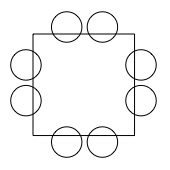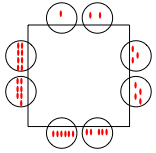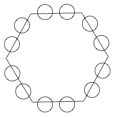So, you are at the party and sitting around the table with seven friends.

At the top left-hand corner is the friend who is giving the party. She or he has a bag of sweets and starts giving them out in a clockwise direction: one for themselves, two for the next person and three for the next and so on.

There are other similar parties going on at the same time. They have bigger square tables with more children sitting round on each side.
Explore and compare all the tables: 2 on each side, 3 on each side, 4 on each side and 5 on each side.
You could look at:
the total number of sweets that children sitting opposite each other have;
the total number of sweets needed for each size of the table;
the total number of sweets belonging to children who are diagonally opposite.
Then, what about five- and six-sided tables?

